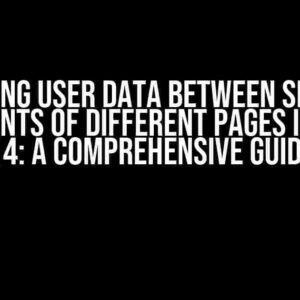Are you tired of staring at a blank screen, wondering why your QWebEngineView is refusing to render your pydeck HTML? Fear not, dear developer, for we’re about to embark on a thrilling adventure to unravel the mystery behind this pesky issue. Buckle up, and let’s dive into the world of QWebEngineView and pydeck!
What is QWebEngineView?
QWebEngineView is a powerful tool for rendering web content in Qt applications. It’s based on the Chromium browser engine and provides a rich set of features for displaying HTML, CSS, and JavaScript content. When used in conjunction with pydeck, a Python library for creating interactive 3D visualizations, you’d expect a seamless integration. But, as we all know, expectations can sometimes lead to disappointment.
What is pydeck?
pydeck is an incredible library for generating interactive 3D visualizations in Python. By leveraging the power of WebGL and Deck.gl, pydeck enables you to create stunning, data-driven visualizations that will leave your users in awe. However, when paired with QWebEngineView, things can get a bit tricky.
The Problem: QWebEngineView Not Rendering PyDeck HTML
You’ve followed the tutorials, consulted the documentation, and written what you thought was the correct code. But, when you run your application, QWebEngineView stubbornly refuses to render your pydeck HTML. The screen remains blank, taunting you with its emptiness. It’s as if the two technologies are at odds, refusing to play nice together.
debugging 101: Identifying the Culprit
To resolve this issue, we need to identify the root cause. Let’s start by examining the most common culprits:
QWebEngineViewnot properly initialized- pydeck HTML not correctly generated
- Incompatible versions of Qt and pydeck
- Conflicting CSS styles or JavaScript libraries
- Lack of necessary permissions or resources
Step-by-Step Troubleshooting Guide
Fear not, dear developer, for we’re about to embark on a step-by-step journey to troubleshoot and resolve this issue. Follow these instructions carefully, and we’ll have QWebEngineView rendering your pydeck HTML in no time:
-
Verify QWebEngineView Initialization
import sys from PyQt5.QtCore import * from PyQt5.QtWebEngineWidgets import * from PyQt5.QtWidgets import QApplication app = QApplication(sys.argv) view = QWebEngineView() view.setHtml(html_content) # Replace with your pydeck HTML content view.show() sys.exit(app.exec_())Ensure your QWebEngineView is properly initialized and configured.
-
Check pydeck HTML Generation
import pydeck as pdk map_view = pdk.View(type_='map', map_style=pdk.map_styles.ROAD_MAP) layer = pdk.Layer('GeoJsonLayer', 'my-layer', data='path/to/your/data.json') deck = pdk.Deck(layers=[layer], views=[map_view], map_provider=None) html = deck.to_html()Verify that your pydeck HTML is correctly generated and contains the necessary elements for rendering.
-
Verify Compatibility Between Qt and pydeck
Qt Version pydeck Version Qt 5.12 or later pydeck 0.3.0 or later Ensure you’re using compatible versions of Qt and pydeck. Check the official documentation for the latest compatibility information.
-
Inspect Conflicting CSS Styles or JavaScript Libraries
Inspect your CSS and JavaScript code for any potential conflicts. Try removing or commenting out sections to isolate the issue.
-
Verify Necessary Permissions and Resources
Ensure your application has the necessary permissions and resources to access the required files and data.
Additional Tips and Tricks
While troubleshooting, keep the following tips in mind:
- Use the
QWebEngineView::setHtml()method to set the HTML content, rather thanQWebEngineView::setUrl(). - Verify that your pydeck HTML content is correctly encoded and contains the necessary metadata.
- Check for any JavaScript errors or warnings in the QWebEngineView console.
- Try rendering a simple HTML page to ensure QWebEngineView is functioning correctly.
Conclusion
By following these steps and troubleshooting guidelines, you should be able to resolve the issue of QWebEngineView not rendering your pydeck HTML. Remember to stay patient, persistent, and creative in your problem-solving approach. With a little bit of determination and a solid understanding of the technologies involved, you’ll be displaying stunning pydeck visualizations in no time.
Happy coding, and may the rendering be with you!
Frequently Asked Question
Get answers to your most pressing questions about QWebEngineView not rendering PyDeck HTML!
Why is my QWebEngineView not rendering my PyDeck HTML?
This could be due to the fact that QWebEngineView requires a running Qt event loop to function properly. Make sure you have initialized the Qt application and started the event loop before loading the HTML content. Additionally, ensure that the HTML content is correctly formatted and the PyDeck library is properly installed and imported.
Do I need to use a specific version of Qt or PyDeck for QWebEngineView to work?
Yes, QWebEngineView requires Qt 5.4 or later, and PyDeck 0.7.1 or later. Ensure you are using compatible versions of these libraries to avoid rendering issues. Additionally, check the PyDeck documentation for any specific version requirements or dependencies.
How do I debug QWebEngineView rendering issues with PyDeck HTML?
To debug rendering issues, enable the Qt debug logs by setting the QT_DEBUG_PLUGINS environment variable to 1. This will provide more detailed error messages and help you identify the root cause of the issue. Additionally, use the QWebEngineView’s built-in inspection tools, such as the Web Inspector, to inspect the HTML content and identify any rendering issues.
Can I use QWebEngineView with PyDeck in a multithreaded application?
Yes, QWebEngineView can be used in a multithreaded application, but you’ll need to ensure that the Qt event loop is running in the main thread. Use the QThread or QCoreApplication classes to manage the threads and ensure that the QWebEngineView is created and accessed from the main thread. This will help prevent rendering issues and crashes.
Are there any alternative libraries or solutions for rendering PyDeck HTML besides QWebEngineView?
Yes, there are alternative libraries and solutions for rendering PyDeck HTML, such as PyQtWebEngine, PySide2, or even using a Python-based web framework like Flask or Django. However, QWebEngineView is a popular and widely-used solution for integrating PyDeck HTML into desktop applications. If you’re experiencing rendering issues, try exploring these alternative libraries or solutions to find the best fit for your project.




